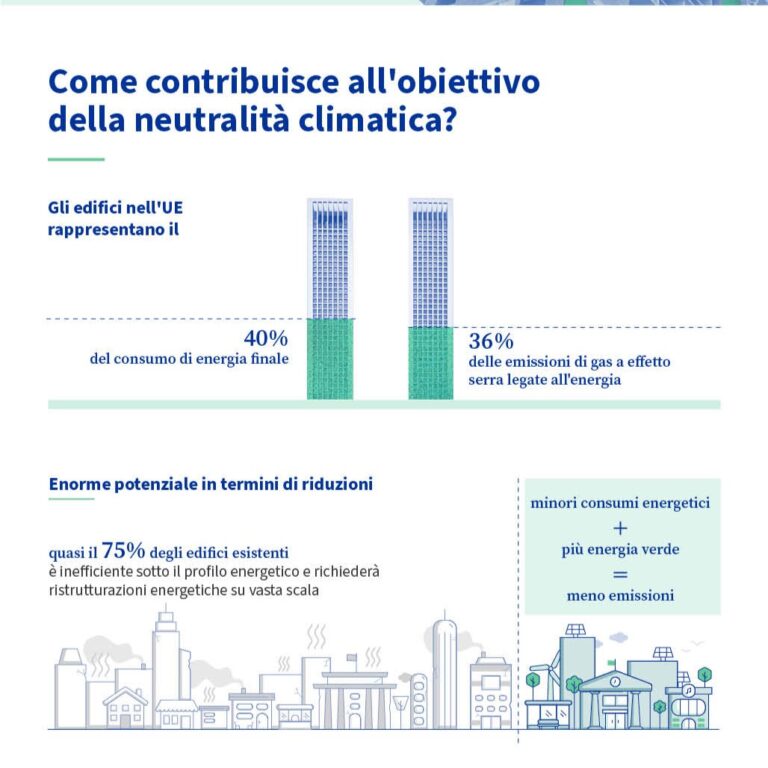The EPBD IV Directive, or “Green Homes” Directive, accelerates the decarbonization of buildings through a clear roadmap and introduces a strong push for the widespread use of EPCs. While still underutilized, these certificates are potentially essential for devising strategies based on real data about the building stock. For this reason, the EPBD expands and renews the requirements for Energy Performance Certificates (EPCs), from digital EPCs to the integration of the Smart Readiness Indicator (SRI). Discover all the updates.
Contents
The Energy Performance Certificate (EPC) is now a well-known tool in the building sector. Introduced in Italy in 2009 and subsequently updated, it represents a key element in implementing the EPBD Directive, contributing to the definition of minimum energy performance requirements for buildings.
However, according to the latest ENEA report, out of 32 million housing units in Italy, only 5.5 million have an EPC considered reliable—just under 20%—while renovation rates are still around 1%. In this context, the new EPBD reaffirms its role as a fundamental regulatory driver to consolidate the use of this tool and achieve the objectives of the Fit for 55 Plan, the European roadmap for a “green transition,” aiming for a fully decarbonized building stock and Zero Emission Buildings (ZEB) by 2050.
Key Updates Introduced by the EPBD Recast
The new EPBD Directive brings substantial updates to the EPC, introducing a more uniform certification model at the European level. By May 29, 2026, all EPCs must comply with the new model and calculation methodology, marking an important step toward greater harmonization of energy certification procedures at the EU level.

All issued EPCs must also be entered into a dedicated national database to create a centralized and accessible archive of building energy performance. Finally, Member States will be required to carry out periodic checks to verify the correct implementation of the new provisions and ensure compliance with the obligations.
Another key aspect concerns the preliminary evaluation: for buildings under construction or renovation, a preliminary estimate of energy performance can be provided, to be confirmed or updated at the end of the works. New EPCs will also have to provide information on the type of heating system and recommendations to achieve optimal performance levels, taking into account costs and lifecycle emissions reductions.
Finally, it is important to note that the legal effects of non-compliance with EPC obligations are defined by the national regulations of each Member State.
Mandatory EPC Information:
- Energy Performance Class: The new energy classification of buildings will adopt a scale from A to G, where A indicates zero-emission buildings, and G corresponds to the least efficient buildings.
- Annual Primary and Final Energy Consumption
- Percentage of Renewable Energy Produced On-Site (e.g., solar panels)
- Operational Greenhouse Gas Emissions
- Total Energy Consumption: Breakdown of consumption by different energy types (electric, thermal, etc.).
- Energy Demand: The amount of energy required to meet the building’s needs.
- Capacity to React to External Signals and Operate at Efficient Temperatures: Assessment of the building’s ability to adapt to changing climatic conditions and maintain comfortable temperatures with minimal energy expenditure.
Among other updates to include:
-
Global Warming Potential (GWP): GWP is an indicator that measures a building’s impact on global warming, considering all phases of its lifecycle—from material production to demolition. Essentially, it calculates the quantity of greenhouse gases emitted by a building, expressed in CO₂ equivalents.
- By 2027, Member States must present a plan to achieve these objectives.
- Starting January 1, 2028, the GWP during the lifecycle must be calculated and reported in the EPC for buildings with a usable covered area greater than 1,000 m².
- From 2030, Member States will be required to set maximum GWP limits for new buildings.
- Contact Information for a Relevant Single Contact Point for Renovation Consultation: This will provide simplified advice and information on technical and financial solutions to improve property performance.
Optional Information: SRI within the EPC
- Specific Energy Efficiency for Different Uses: Detailed analysis of energy efficiency for different building uses (heating, cooling, lighting, etc.).
- Overheating Risk Analysis: Evaluation of the probability of the building experiencing summer overheating.
- Presence of Air Quality Sensors: Indication of systems monitoring indoor air quality.
- Electric Vehicle Charging Points: Number and type of charging points available.
- Adaptation Potential of Systems: Assessment of the potential for improving energy efficiency through interventions on existing systems.
The EPC, prepared by independent experts following an inspection (including virtual ones), will contain recommendations for improving energy efficiency and indoor air quality unless the building has already achieved energy class A.
New Digital EPC: When It Is Required
- New Buildings: From 2028, all new buildings over 1,000 m² must have an EPC, and from 2030, all new buildings, regardless of size, will require one.
- Deep Renovations: In cases of renovations significantly altering a building’s energy characteristics, a new EPC is mandatory.
- Sale or Rent: An EPC is required for properties sold or rented, and property listings must include the energy class.
- Public Buildings: Buildings occupied by public entities must have an EPC.
Exceptions:
Certain buildings may be exempt from these obligations, such as:
- Seasonal Use: Residential buildings used less than four months per year.
- Low Energy Consumption: Buildings with very low expected energy consumption.
Impacts of the New EPC for Citizens, Public Authorities, and Assessors
The new regulation aims to increase transparency, making energy performance information readily available to all citizens, enabling more informed decisions. At the same time, the EPC is a crucial tool for incentivizing renovation and promoting the construction of low-consumption buildings. A solid understanding of real data also helps public authorities develop more effective and targeted energy policies.
For professionals, mandatory EPC registration in a national database simplifies activity monitoring. Digitalization of the EPC can open up new business opportunities, such as offering advanced energy consultancy services or developing software and platforms for EPC management. However, it also requires additional training for assessors, who must familiarize themselves with digital software for the new EPC and attend specific training courses.
SRI and EPC are increasingly working in synergy. If you want to learn more about the EPBD updates regarding the SRI, read our dedicated article.

























